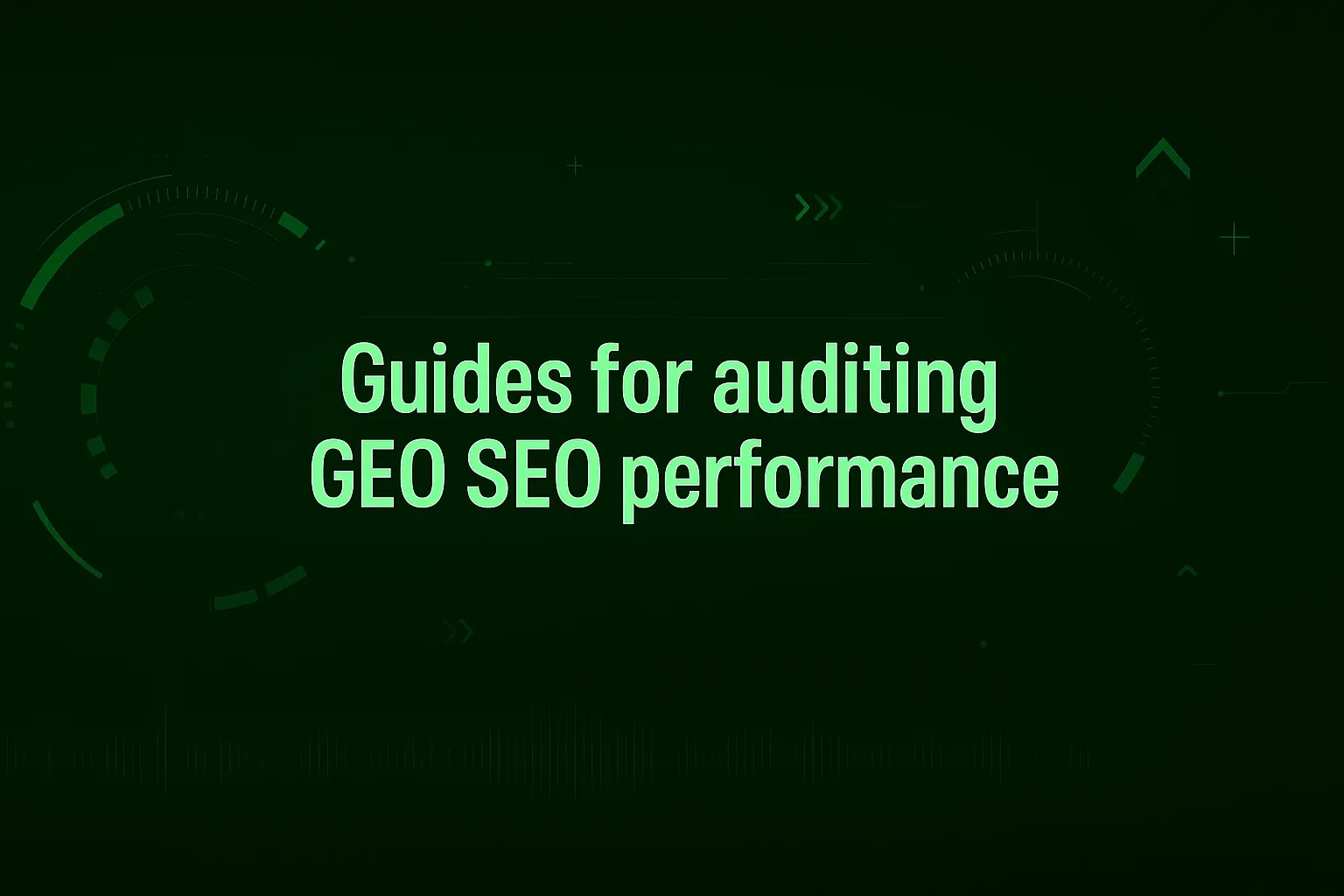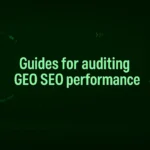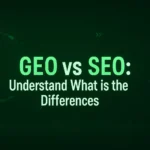
Table of Contents
Summary
This blog will guide you step-by-step and take you through a full GEO audit, explaining what to look for and how to improve your website for AI search. It will use simple language and simple ideas in a clear fashion, making it easy to understand and follow, even if you are a novice in the areas of indoor positioning, AI, or SEO. In reviewing your site, looking for problems, fixing those problems, and generating AI traffic and visibility to your site, you will understand how the process works and what needs to be done.
Introduction
Generative Engine Optimization (GEO) is a new method to improve the visibility of your content via AI search engines, including ChatGPT, Google Bard, and others. Most AI tools do not present links like traditional search engines; instead, they generate an answer by leveraging content from trusted websites. The GEO approach sets up your content for AI search tools to find, consume, and trust that it is relevant enough to include in the answer. To maintain its mostly relevant state, you have to perform a GEO audit, which simply means check your content periodically to see what is good and what needs to be made better.
Understanding the Basics of GEO
Before you evaluate your content, it’s helpful to know what GEO means. SEO is making your website show up higher on Google through keywords and backlinks. GEO is different. GEO is about enabling AI tools to discover, interpret, and utilize your content when those tools create answers for users.
When answering questions, AI engines select which content to show or quote. Because of this, your content should be clear, credible, and offer a significant amount of contextual information. If it is ambiguous or ambiguous and weak, AI will ignore it. GEO also means writing specifically for understandability by AI, using a natural and human-like way of finding and including related topics and keywords in a fluid but human-like manner.
A lot of businesses struggle with this new version of SEO. The reason is this process requires more of a focus on quality and trust than just keywords or rankings. That is why you would want any type of audit for your GEO. It will give you a place to see where you are at and where you need to improve so you can have your content picked up by AI and have your content shown more.
Step 1: How to Check if Your Content Works Well for AI
The first step in your GEO audit is to examine your content and determine if AI likes to find and learn what you’re trying to say. AI engines like content that is organized well, clear, and provides a complete answer to common questions about your topic.
At the start of your audit, confirm that your content is organized in a clear structure. You can use headings and subheadings to describe to the user what to expect in that section. Large paragraphs can be broken into smaller paragraphs. You can even make some of these items into bullets and lists, as these types of elements are easier to scan and use. AI tends to prefer content that is easy to read and easy to consume.
Then, consider whether you include terms and concepts that are relevant to the topic. This is also known as semantic relevance.
For example, if you write about “digital marketing,” use associated ideas like SEO, content marketing, social media and analytics repeatedly throughout your content. This will reinforce the understanding of your content as complete and trustworthy for AI.
Also make sure that your content is accurate and comprehensive. You want to make sure to avoid leaving out key details or leaving unanswered questions. AI engines are trying to give the best possible answers, so you want your content to be a complete reference on the topic.
Step 2: How to Make Your Content Trustworthy for AI
The next phase of your GEO audit takes an in-depth look at the trustworthiness and credibility of your content. AI engines prefer sources that are deemed experts or leaders in that particular field.
Examine your backlinks—links from other websites that connect to your content. Good quality backlinks from quality, credible sites will increase your authority. Determine whether you have enough of those links and where they are from. If you do not have enough, plan to get backlinks from trusted websites in your niche.
Always make it clear who wrote the content. Including a paragraph or brief bio about the writer and their experience makes people more trusting of it. If you’re including numbers or facts, you need to say where you got that information from. And include quotations from experts or research to make your content generally more actionable.
To be trusted, you need to be clear and consistent. Your facts should line up and stay on track. Don’t make large claims you can’t support. AI likes concrete, clear, and well-supported content.
Step 3: Technical SEO Steps for GEO
GEO still has elements of technical SEO. AI engines crawl the web in a very similar way to other search engines.
You should start your audit of two spaces by checking the load speed of your site first. AI, like visitors, have a preference for fast-loading sites. For free, you can check the quality of your site and where you need improvements with Google PageSpeed Insights.
You should also check if your site works for mobile devices. Many users search from their phones, and AI engines use mobile-friendliness as a ranking factor.
See the title and details on each page. They should be clear and include the correct keywords so that AI knows what the page is. Make sure AI can easily find and read your content. Do not hide the important text inside the code or only show it as an image. AI cannot “read” images well, so always keep the main material in plain text.
Use structured data (schema) such as articles, FAQs, or folklore. This helps AI to understand your site better and can give rich, more useful answers.
Step 4: Improving User Experience for GEO
The user experience affects how AI gives importance to your content. AI assumes how real users attach to your pages as a sign of quality. Check the readability of your content. Use simple sentences that are as long as necessary, and avoid jargon or complex words. Make paragraphs small and flow naturally.
Analyze the engagement metrics, such as how long visitors stay on your page, bounce rates (how fast visitors leave), and repeat trips. If these numbers are bad, your content may need to be more interesting or helpful. Ensure your content answers user questions completely.
If your audience is searching for specific information, your content should provide clear and complete reactions. This keeps visitors happy and enhances your site’s reputation with AI.
Step 5: Measuring Your GEO Result
After rectifying, you need to measure how your content performs in AI search. Use special devices that track your site mentions or quotes in AI-related answers. Some SEO platforms now provide features for monitoring AI appearance. See the referral traffic report to see how many visitors come from AI discoveries or chat platforms.
Evaluate the relevance of the keywords for your content rank. By analyzing the related topics and search intentions, you can see if AI understands your content correctly. This data helps you adjust your strategy and focus on areas that require more work.
Step 6: Creating and Following Your GEO Plan
Once your audit is completed, organize your comments in a clear plan. Prioritize the fix based on what the biggest result will be.
For example, starting with material clarity can be more effective than the creation of backlinks if your current pages are confused. Set specific goals for each region, such as updating three pages per month or receiving five new backlinks quarterly. Use the tool to track your progress and to maintain your GEO performance; schedule regular audits like quarterly reviews.
Additional suggestions to stay ahead in GEO AI search change rapidly. Stay updated by following the news of Google, OpenAI, and industry experts. Use AI tools that analyze the readiness of your content for the generative engine. These can highlight problems before doing AI. Mix your live efforts with traditional SEO strategies such as keyword research and link building for a strong overall strategy.
Conclusion
In today’s world, auditing your generative engine optimization (GEO) is important to ensure that your brand is visible and reliable to AI-operated search engines. By regular checking and correction of clarity, reliability, and technical readiness of your content, the Badiya brand can become a top option for AI-generated answers.
Now start your live audit and control your digital future. AI wants to lead the way in search? Reach till date and help us shine the Badiya brand where it matters the most.




